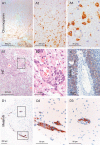The metastatic infiltration at the metastasis/brain parenchyma-interface is very heterogeneous and has a significant impact on survival in a prospective study
- PMID: 26299612
- PMCID: PMC4745724
- DOI: 10.18632/oncotarget.4201
The metastatic infiltration at the metastasis/brain parenchyma-interface is very heterogeneous and has a significant impact on survival in a prospective study
Abstract
The current approach to brain metastases resection is macroscopic removal of metastasis until reaching the glial pseudo-capsule (gross total resection (GTR)). However, autopsy studies demonstrated infiltrating metastatic cells into the parenchyma at the metastasis/brain parenchyma (M/BP)-interface.
Aims/methods: To analyze the astrocyte reaction and metastatic infiltration pattern at the M/BP-interface with an organotypic brain slice coculture system. Secondly, to evaluate the significance of infiltrating metastatic tumor cells in a prospective biopsy study. Therefore, after GTR, biopsies were obtained from the brain parenchyma beyond the glial pseudo-capsule and analyzed histomorphologically.
Results: The coculture revealed three types of cancer cell infiltration. Interestingly, the astrocyte reaction was significantly different in the coculture with a benign, neuroectodermal-derived cell line. In the prospective biopsy study 58/167 (34.7%) samples revealed infiltrating metastatic cells. Altogether, 25/39 patients (64.1%) had proven to exhibit infiltration in at least one biopsy specimen with significant impact on survival (OS) (3.4 HR; p = 0.009; 2-year OS was 6.6% versus 43.5%). Exceptionally, in the non-infiltrating cohort three patients were long-term survivors.
Conclusions: Metastatic infiltration has a significant impact on prognosis. Secondly, the astrocyte reaction at the M/BP-interface is heterogeneous and supports our previous concept of the organ-specific defense against metastatic (organ-foreign) cells.
Keywords: astrocytes; brain metastasis; glial-pseudo capsule; metastatic infiltration; organ-specific defense.
Conflict of interest statement
The authors do not report any conflicts of interest.
Figures






References
-
- Raore B, Schniederjan M, Prabhu R, Brat DJ, Shu HK, Olson JJ. Metastasis infiltration: an investigation of the postoperative brain-tumor interface. International journal of radiation oncology, biology, physics. 2011;81:1075–1080. - PubMed
-
- Baumert BG, Rutten I, Dehing-Oberije C, Twijnstra A, Dirx MJ, Debougnoux-Huppertz RM, Lambin P, Kubat B. A pathology-based substrate for target definition in radiosurgery of brain metastases. IntJRadiatOncolBiolPhys. 2006;66:187–194. - PubMed
-
- Neves S, Mazal PR, Wanschitz J, Rudnay AC, Drlicek M, Czech T, Wustinger C, Budka H. Pseudogliomatous growth pattern of anaplastic small cell carcinomas metastatic to the brain. Clinical neuropathology. 2001;20:38–42. - PubMed
Publication types
MeSH terms
Substances
LinkOut - more resources
Full Text Sources
Other Literature Sources
Medical

